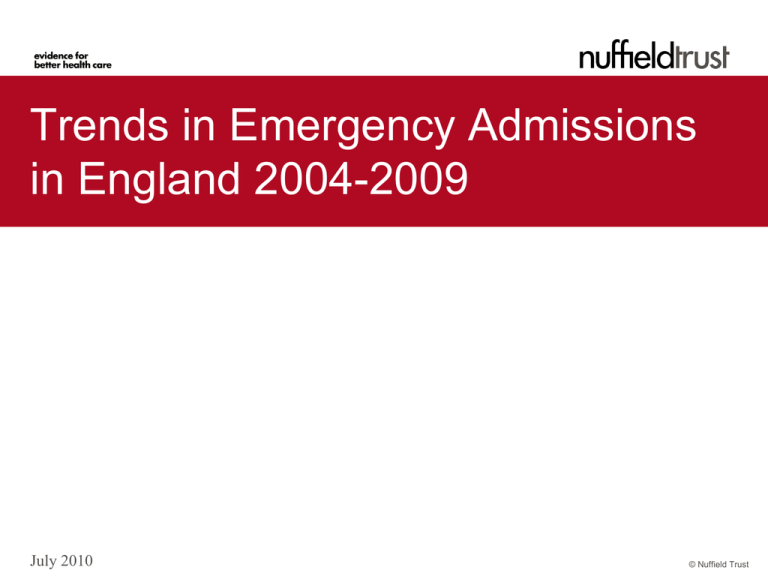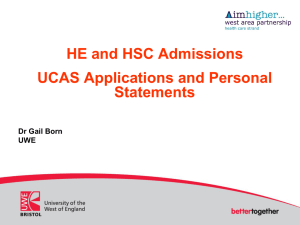
Trends in Emergency Admissions
in England 2004-2009
July 2010
© Nuffield Trust
Why emergency admissions?
Emergency hospital admission is:
• Undesirable
• Expensive
• Recorded in routine data
and
• Thought to be increasing in number
© Nuffield Trust
Are emergency admissions rising?
Possible reasons
•Aging population
•Public expectations
•More treatable
illness
•Defensive medicine
•Central targets/
Payment by Results
•Changes in other
linked services
Number of emergency admissions in England 1996-2009,
with period investigated marked in red
Reproduced from Trends in emergency admissions in England 2004-2009: is greater efficiency breeding inefficiency?
•Over reliance on
A&E for urgent care
Is it just emergency admissions?
Reproduced from Trends in emergency admissions in England 2004-2009: is greater efficiency breeding inefficiency
Our analysis
The aims of the research were to:
• Unpick the rise in admissions
• Highlight characteristics of excess admissions
• Explore variation at hospital and area level
This work used the Hospital Episodes Statistics (HES)
dataset to examine monthly emergency admissions over a
five year period from April 2004 to March 2009.
© Nuffield Trust
Is the increase due to more readmissions?
How does the rise consume resources?
Estimated cost of the rise
in emergency admissions
is equivalent to at least an
additional £330 million in
2008/09 (compared to
2004/05 activity costed at
2008/09 payment levels).
2.5
2.4
2.2
2.1
2
1.9
1.8
1.7
1.6
Not clipped
Clipped 3 months
1.5
200404
200406
200408
200410
200412
200502
200504
200506
200508
200510
200512
200602
200604
200606
200608
200610
200612
200702
200704
200706
200708
200710
200712
200802
200804
200806
200808
200810
200812
200902
Emergency bed days (millions)
2.3
However, the actual value
is likely to be higher due to
inflation in the tariff over
time and payment for nontariff work.
Is the pattern of stay length changing?
Number of emergency admissions categorised by emergency bed days (EBDs) used in spell,
excluding spells in mental health and undefined Healthcare Resource Groups (HRGs) 2001-2009
Reproduced from Trends in emergency admissions in England 2004-2009: is greater efficiency breeding inefficiency?
Is the increase related to age?
Reproduced from Trends in emergency admissions in England 2004-2009: is greater efficiency breeding inefficiency
Has the case mix of emergency admissions changed?
Has the case fatality rate changed?
30000
15%
13%
25000
11%
Deaths
20000
9%
15000
7%
5%
10000
3%
5000
1%
0
-1%
Observed
Expected
Percentage of emergency admissions that end with death
Emergency admissions that end in death, showing observed deaths, expected deaths (standardised for age, sex, and HRG at
2004/05 rates) and percentage of total emergency admissions
Is the rise linked to the A&E target in England?
Trade-off analysis between four-hour target breaches and short stay emergency admissions in England (all A&E types)
Reproduced from Trends in emergency admissions in England 2004-2009: is greater efficiency breeding inefficiency?
Is the rise linked to the A&E target in particular trusts?
Trade-off analysis between four-hour target breaches and short stay emergency admissions in
another trust (all A&E types)
Reproduced from Trends in emergency admissions in England 2004-2009: is greater efficiency breeding inefficiency
Do all PCTs show the same pattern?
(a) Age and sex
standardised emergency
admission ratio in
2004/05 (green, lowest,
to red, highest)
(b) Absolute increase by
2008/09 (blue, dark =
highest, light = lowest)
Reproduced from Trends in emergency admissions in England 2004-2009: is greater efficiency breeding inefficiency?
The evidence in summary...
Possible reason
Comments
Aging population
Accounts for some of the increase, but not all
Public expectations
Increased demand for health services
More treatable illness
No significant change in case mix, although vague
symptoms increase disproportionately
Defensive medicine
The increase is due to short stay admissions; but could
be many other explanations for these...
Central targets/Payment
by Results
No evidence of 4-hour target driving systematic
increase, and slightly pre-dates PbR
Change in other linked
services
Could regional variation in the increase be a symptom
of this?
Over reliance on A&E for
urgent care
A&E attendance is increasing, as are admissions
through A&E
Efficiency breeds inefficiency paradox?
Reduction in
length of stay
Provider efficiency
Less severe
cases
admitted
Better and more
efficient care
More
beds
available
System inefficiency
Admission
threshold reduced
Lower acuity cases using
costly inpatient care
www.nuffieldtrust.org.uk
Sign-up for our newsletter
www.nuffieldtrust.org.uk/newsletter
Follow us on Twitter
(http://twitter.com/NuffieldTrust)
July 2010
© Nuffield Trust







